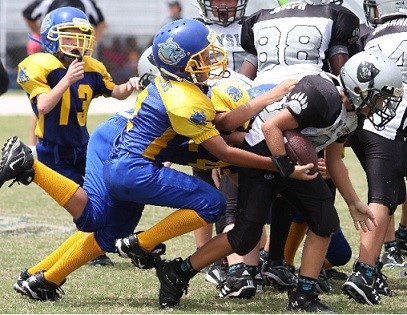
Each year injuries resulting from fall sports are responsible for sending 480,000 kids to emergency rooms across the country.
Participation in fall sports is a great opportunity for children of all ages to learn the merits of teamwork and strategy while also helping to keep them physically fit. In today’s age of videogames and television, fall sports play an important role in battling childhood obesity.
With every sport, there is always a potential risk of injury. Some sports such as football and lacrosse carry with them higher rates of concussions, while other sports such as soccer and basketball put kids at risk for other injuries such as torn ligaments and sprains.
No matter what the sport, there are several important tips that students and coaches can take to help prevent injuries and make sure that their fall season is a great one.
Preventing Heat Injuries
Preventing heat injuries and stroke should always be on the top of the list for sports that are practiced and played outdoors. Football players are particularly at risk of heat illness and heat stroke. With long practices that can often last all day, it is imperative that coaches take the proper precautions.
Fluid replacement strategies are key; there should always be water and sports drinks with electrolytes on hand to replenish what the players lose during vigorous exercise. Coaches should never push their players too hard when it is exceptionally hot outside. Frequent water and rest breaks should be taken to play it safe, in the shade if at all possible. On especially hot and humid days it is recommended that players wear less padding and gear; this allows their bodies to cool off faster. Above all else, coaches should be mindful and proactive of their player’s physical state: if they notice a player acting strangely or not drinking enough fluids, they should intervene immediately. The “buddy system” should also be implemented to protect against heat injury: if one player notices their partner is having difficulty, they need to speak up immediately so fluids can be administered and the player can rest.
Education of coaches and support staff on how to prevent, identify, and treat heat injuries should be completed each year before the season begins. Adequate medical support should always be available on-site to monitor the players for potential problems and administer aid as necessary.
Helping to Prevent All Other Injuries
Injuries such as concussions, sprains, broken bones, and tears are also common during the fall sports season. While not all injuries can be prevented, many can be avoided with the proper precautions and education.
Make sure your child had a physical exam every year. The doctor will be able to check to see if their physical condition may put them at a higher risk for injuries. It is advised to always check with your child’s doctor prior to enrolling them in any vigorous sports program.
Depending on the sport, it is essential to make sure that your child has the correct and recommended safety equipment/gear. For high impact sports such as football, helmets, and mouth-guards are key. The helmet should never be too loose or too tight and should fit securely during gameplay. Most sports use at least some type of padding or safety equipment, whether it be protective eye-guards, mouthpieces, or joint protection. Make sure your child is suited up properly before each game and practice; not wearing even a small piece of safety gear can have drastic and unfortunate consequences down the road.
Before intensive practice and game-play, kids should warm up slowly with low-intensity aerobic activity. This helps to loosen up muscles and joints which prevents sprains and tears.
Make sure your child follows the rules of the game and that the coach does not allow illegal moves or tactics. This should, of course, be a given, but unfortunately every year several children are injured as a result of overly rough and illegal gameplay.
Stretching after games and practice will improve flexibility and help prevent future injuries.
If your children follow these simple tips, they can enjoy all of the teamwork and excitement of fall sports while minimizing their injury risk.
For more sports injury tips and tricks, please visit the National Institute of Arthritis and Musculoskeletal and Skin Diseases (NIAMS) page on Sports Injuries